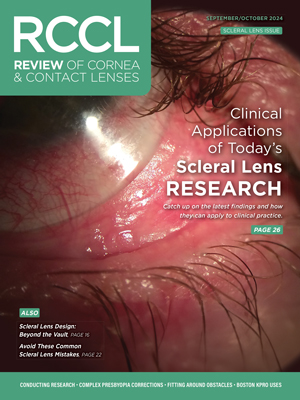 |
Have you noticed the new catch phrase, “wellness of the ocular surface”? It heralds a change in thinking that emphasizes routine screening and maintenance in all patients. Indeed, the most important part of an initial diagnostic exam for lens wearers is an accurate assessment of the ocular surface, as many contact lens-related problems can be blamed on an unstable tear film, lid disease or overall poor ocular surface health.
Fortunately, we’re now armed with ways to assess and treat ocular wellness. When I started in practice three decades ago, artificial tears were the mainstay of ocular surface treatment, and sometimes the only option for combating an issue. Our inability to accurately diagnose the problem was also a major impediment—for example, until recently dry eye was mostly attributed solely to aqueous deficiency. Now, however, we know that’s not the case.
Dry eye is a complex disease with many interactions and cascades. In the last four decades, researchers like James McCulley, MD, and others have refined a classification scheme based on research data. For example, his work on lid disease has led to the reclassification of posterior blepharitis into three broad categories: hypersecretory MGD (also called meibomian seborrhea), hyposecretory MGD (either primary or obstructive) and turbid hypersecretory MGD. Other research has revealed as many as 50% of all patients with blepharitis co-present with dry eye, likely because the detergent effect on the lipid layer alters epithelial cell membranes, leading to cell death and inflammation—a possible contribution to an aqueous-deficient dry eye.
Point of Care Options
New in-office testing options have also changed how we handle this broad disease category by reducing diagnosis time, improving patient education and acting as a metric to assess treatment effectiveness. In addition to TearLab’s osmolarity test, newer procedures include the following:
• InflammaDry (RPS) provides an assay of the proteolytic enzyme matrix metalloproteinase 9 (MMP-9). A marker for inflammation, MMP-9 is a measure of epithelial cell stress and is complementary to measuring tear osmolarity; its real value, however, is in identifying risk and treatable problems that respond to steroid and immunomodulator therapy. We know that if the test is negative for MMP-9, the patient’s issue is not dry eye-related. The opposite, however, is not true: a positive response (i.e., >40ng/mL) doesn’t serve as confirmation of dry eye disease since there are many different conditions with an elevated MMP-9 value.
• The TearScan MicroAssay offers two diagnostic tests: one detects tear film lactoferrin content to assess lacrimal gland function and the other quantifies IgE to gauge the allergic component of ocular inflammation. It has a relatively good sensitivity in detecting an aqueous-deficient dry eye.
• One in 10 dry eye patients have Sjögren’s syndrome. Unfortunately, detection of conventional or traditional biomarkers for SS-A (Ro) and SS-B (La) is only about 70% sensitive in confirming a diagnosis. Early diagnosis of Sjögren’s is critical, as its morbidity is troubling and its link to lymphoma—including non-Hodgkins lymphoma—is well established. Now, other novel biomarkers such as salivary protein-1, carbonic anhydrase-6, and parotid secretory protein, instead offer extremely sensitive measures of early Sjögren’s. They can be identified using the Sjö test from Nicox.
Ongoing R&D involving secretagogues, IL-1 blocking anti-inflammatories, LFA-1 antagonists, selective glucocorticoid receptor agonists and even androgen modulation promise more treatment breakthroughs coming down the pike.
In the face of all these new developments, however, let us not forget that decades ago our knowledge and techniques, while crude, still helped our patients achieve some symptomatic relief. Assessing the tear film, looking for debris and meniscus height, staining the cornea and conjunctiva and looking for lid pathology helped shape our diagnostic decisions and treatment plans then, and still have relevance today.
In closing, thank you to our pioneers for paving the way and asking the right questions that led to the products we have today. I’m certain anyone looking back decades from now will be as equally amazed at the progress made combating ocular surface disease, particularly dry eye disease. We look forward to the future work that helps assess the “vital signs” of ocular wellness that’s sure to come. Stay tuned!


